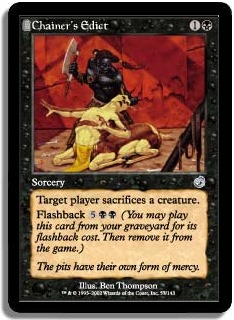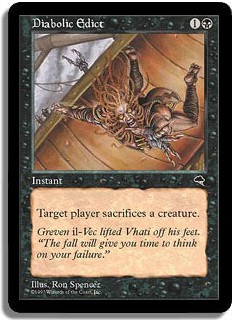In the world of cube, many cards are universally powerful. Both Flametongue Kavu’s ability to deal four damage to opposing creatures and Vampiric
Tutor’s ability to look through a deck for answers make both of these cards cube staples. Their function is pretty straightforward and their use in all
cubes is similar no matter what cube you’re drafting from.
However, not all cards function so similarly. The Cube Comparison thread on
MTGSalvation shows that there are many cards (like the aforementioned Flametongue Kavu and Vampiric Tutor) that are used in nearly every
cube. However, not every cube is the same and the differing environments found in different cubes can make cards perform differently. That environment
can make a card perform better or worse. How? I’ll use a few examples, from when cards were reprinted and how the different environments affected how
the cards performed.
The first example is a hypothetical one. Lone Missionary was a card that was pretty lackluster in Rise of the Eldrazi draft. Its 2/1 body wasn’t very
relevant when many other creatures in the format were either walls that could block the 2/1 all day, were huge Eldrazi that annihilated lands and chump
blockers, or were creatures that could level up into something huge and evasive. The main draw of Lone Missionary, its ability to gain 4 life, meant
little in Rise of the Eldrazi since there weren’t many racing situations that could be swung by the gaining of 4 life. Sure, there were times when
gaining four life helped you to win a close game or two, but the overall benefit wasn’t enough to make it a very good card in the format.
However, if Lone Missionary was printed in Zendikar or Worldwake, Lone Missionary would have been better, as its 2/1 body for 1W was on par with the
other cheap creatures in the format (where Goblin Shortcutter was taken pretty highly) and the 4 life would have meant a lot in a format where quick
beats and little blocking defined the fast draft format. Granted, Lone Missionary wouldn’t have been a windmill slam either, but it would have been a
welcome addition to white ZZZ and ZZW draft decks. I found that some people who didn’t get the memo on the slower pace of Rise of the Eldrazi picked
Lone Missionary highly but quickly learned that the rules of Zendikar didn’t apply in Rise of the Eldrazi.
When Harrow was printed in Invasion, its main use was to act as a mana fixer, as the multicolor block encouraged decks using many different basic lands
through its multicolor and domain cards. Harrow’s role was important because the block had few quality mana fixers (as it wasn’t uncommon to run the
6-6-5 basic land special) and Harrow (along with Fertile Ground) helped to contribute to green’s Invasion block draft decks.
Harrow’s role in Zendikar, on the other hand, was mainly to help cards with landfall triggers such as Plated Geopede and Steppe Lynx. As the format was
much faster and had no multicolor cards (outside of cards like Loam Lion and Sejiri Merfolk), Harrow’s previous mana fixing role wasn’t as critical. It
was still useful to get a few Mountains to cast a Plated Geopede or a Goblin Shortcutter in a RG deck, but mana fixing was no longer the primary
function (but still, a useful one) due to the faster environment and relevance of landfall triggers in Zendikar and Worldwake.
What does this have to do with cube? Why am I talking about regular draft environments?
In all of these examples, their performance and roles were affected by the environment itself. It wasn’t like cards like Harrow and Lone Missionary
themselves changed, but their environments did.
Some of the strength of a card can come from explicit support. In my “Supporting Cast”
article, I talked about how cards like Stoneforge Mystic and Life from the Loam can play differently from cube to cube based on the support
for a card in a cube. When it comes to looking at how cards perform differently from cube to cube, many people initially think of these types of cards.
While Stoneforge Mystic wasn’t included in many cubes pre-Scars of Mirrodin, the printing of powerful equipment in that block (Sword of Body and Mind,
Sword of Feast and Famine, Sword of War and Peace, Batterskull, and Bonehoard) gave the card additional support and made it much better, to the point
where many cubes now happily use the 1/2 format definer. With cards like Life from the Loam — it combined with cards like the Zendikar/Onslaught
fetchlands and its myriad of other interactions (feeding Masticores and Stormbind, to name a few) helped to provide Life from the Loam with support to
make it a useful card in many cubes.
But that’s pretty easy, isn’t it? Saying that cards like Stoneforge Mystic get better with more equipment and Life from the Loam gets better with more
ways to put lands into a graveyard isn’t going to shatter anyone’s worldview.
However, other cards like Cruel Ultimatum perform in the same way, which at first seems counter-intuitive. Cruel Ultimatum isn’t searching your library
for equipment to cheat into play, but it is reliant on having enough mana fixing to make it so that casting Cruel Ultimatum can happen consistently in
a game. While Cruel Ultimatum was a cornerstone of 5-color-control decks when it was in Standard and Extended, the mana bases required to make Cruel
Ultimatum work generally don’t happen in cube outside of dedicated Grixis decks (as opposed to something like a UB deck that’s splashing R) and 4 or 5
color control decks with a lot of mana fixing. As powerful as Cruel Ultimatum is, the support and mana fixing isn’t there for Cruel Ultimatum in many
cubes and thus, it isn’t used in many cubes. In fact, many cubes opt to use Nicol Bolas, Planeswalker for that very reason because it’s much easier for
cube decks to adequately support the villainous planeswalker as it’s much easier to get to 4UBBR for the powerful effect.
In the earlier days of my cube, aggressive strategies weren’t very well supported and their relevance in my cube was minimal. In the few times when
aggressive decks were drafted, their lack of support showed and they were unable to compete competitively with the midrange and control-based
archetypes in my cube. Aggro decks were essentially ignored.
Due to the slow speed of my cube where midrange and control decks ruled the roost, Chainer’s Edict was a stronger card in my cube than Diabolic Edict.
The instant speed on Diabolic Edict was trounced by the flashback on Chainer’s Edict, because even though instant speed was useful due to the slow
metagame and the prevalence of slower midrange and control mirrors, getting to 5BB for Chainer’s Edict was much more the rule than the exception. You
could almost always count on getting the 2-for-1 from Chainer’s Edict, which made Chainer’s Edict the superior card back then.
As I began to support aggressive archetypes more and made them a more relevant and powerful part of my cube’s metagame, being able to use the 5BB
flashback on Chainer’s Edict wasn’t a given anymore as control and midrange mirrors weren’t as common (Chainer’s Edict still gets flashed back in my
cube, it just isn’t at near-100% frequency anymore). This made it so that the overall benefit provided by Diabolic Edict’s instant speed was better
than the benefit provided by the flashback on Chainer’s Edict. Just like with the Lone Missionary example, the cards themselves didn’t change, but
their environment did.
Of course, this isn’t to say that I’m anywhere near taking out Chainer’s Edict or Diabolic Edict from my cube. They’re both extremely powerful cube
cards and they both offer unique and powerful tools to cube decks. It’s just that their relative strength changed due to their environment and that if
I were to draft my cube now, I’d take Diabolic Edict higher than Chainer’s Edict, whereas a few years ago, I’d have taken Chainer’s Edict higher.
Some cards like Kozilek, Butcher of Truth and Life’s Finale have higher variances in power level due to a cube’s environment as both cards perform
better in cubes with a slower metagame. It’s for the same reason that Chainer’s Edict was better in my cube’s slower days; they both perform optimally
in the same types of midrange and control mirrors that made Chainer’s Edict much better than Diabolic Edict in my cube of old.
It’s especially apparent on Kozilek, Butcher of Truth, where its ability to draw four cards even when countered and his huge size can have a big effect
on the control and midrange mirrors. This isn’t to say that a card like Life’s Finale is bad (I’d personally rate it behind Black Sun’s Zenith but
ahead of Decree of Pain for non-Damnation black Wrath of God effects) but much like with Kozilek, Butcher of Truth, its power level in cube is greatly
determined by the cube environment and that could determine whether a card whose power varies greatly on the speed of a cube makes it into a cube or
not.
Some time ago, in my friend’s common cube where aggressive archetypes had little support (and relevance as they almost never won), astute drafters
found that using the most mana possible on cards was the best strategy. “I always pay full value for stuff in this cube,” someone said about cards like
Keldon Vandals and Mulldrifter. It’s similar to how you almost always want to draw in Core Set limited so that you can squeeze every little bit of card
advantage out of your cards due to the slow environment. That same idea applied in the slower cubes and showed how the use of cards changed based on
the cube environment.
Aggressive cards like Savannah Lions and Jackal Pup are excellent cards for aggressive cube strategies, but if aggressive strategies aren’t given
proper support, those cards perform poorly. I’ve seen some cubes with the bare minimum of aggressive support (“I have Isamaru, Hound of Konda, Mother
of Runes, Soltari Priest, and Soltari Monk in my 500-card cube, so white aggro’s supported in my cube!”). This results in an environment where
cards like Kird Ape, Goblin Guide and Savannah Lions are essentially “traps,” as someone may think “I got a Goblin Guide 9th pick, red aggro’s totally
open!” but they will end up with a bad deck as the drafter tries to draft a red aggro deck that just isn’t supported, leading to an endgame where the
aggressive cards just go late or the cards get taken out of a cube because no one’s drafting them. Cubes that adequately support aggressive strategies
with those two-power one-drops perform very well in those strategies, so those cards aren’t bad in cube. It’s just that they didn’t have support and
that the proper solution was to give aggressive strategies more support, not to cut what little support was there.
I wrote an article on supporting aggressive archetypes some time ago, but I condensed everything into a dense and hard-to-read block of text (as
opposed to a long and drawn out hard-to-read block of text, as it was my first article after all) when the concept of enabling aggro in cube was still
young and was mostly unheard of. Now that the idea has caught on and many others have had success with it, in future articles, I’ll go into much more
detail on how to enable aggressive archetypes and how to use data to balance your cube and to make aggressive strategies more relevant in your cube.
May all of your opening packs contain Sol Rings!
@UsmanTheRad
on Twitter
My blog featuring my (powered and pauper) cube lists:Â http://idratherbecubing.wordpress.com
Cube podcast that I and Anthony Avitollo co-host: The Third Power






